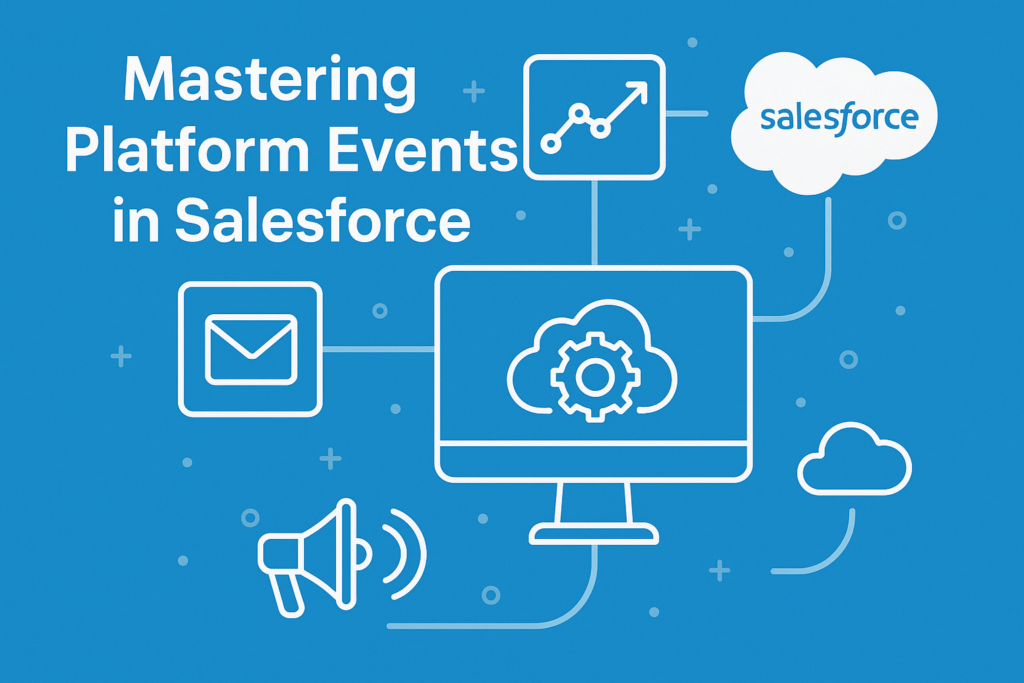🚀 Introduction
In today’s connected world, businesses demand real-time communication between different systems and applications. Salesforce, understanding this growing need, introduced Platform Events — a powerful publish-subscribe model to enable event-driven communication within and outside the Salesforce ecosystem.
In this blog, we’ll explore:
– What are Platform Events?
– Why and when to use them
– How to implement Platform Events in Salesforce
– Real-world use cases
– Code examples for better understanding
🔍 What are Platform Events?
Platform Events are part of Salesforce’s Event-Driven Architecture. They are custom, immutable, and scalable messages that can be published and subscribed to, enabling systems to communicate asynchronously.
They function similarly to message queues (like Kafka or RabbitMQ), allowing Salesforce to interact in real-time with internal apps (Apex triggers, Flows) or external systems (via CometD, Change Data Capture, etc.).
❓ Why Use Platform Events?
- Real-Time Communication: Platform Events allow your apps to react instantly to changes.
- Loose Coupling: The publisher doesn’t need to know about the subscriber.
- Integration with External Systems: You can stream events from Salesforce to external systems using tools like CometD.
- Asynchronous Processing: Processes can be offloaded for asynchronous execution.
🛠️ How to Use Platform Events in Salesforce
Step 1: Define a Platform Event
Go to: Setup → Platform Events → New Platform Event
Example: Create a Platform Event called Order_Event__e with fields: Order_Id__c, Customer_Email__c, Order_Status__c
Step 2: Publish Events
Publish via Apex:
Order_Event__e eventObj = new Order_Event__e(
Order_Id__c = ‘ORD1234’,
Customer_Email__c = ‘customer@example.com’,
Order_Status__c = ‘Confirmed’
);
Database.SaveResult result = EventBus.publish(eventObj);
Publish via Flow: Use “Create Record” element and choose your Platform Event object.
Step 3: Subscribe to Events
Subscribe Using Apex Trigger:
trigger OrderEventTrigger on Order_Event__e (after insert) {
for (Order_Event__e event : Trigger.New) {
System.debug(‘Received Order: ‘ + event.Order_Id__c);
}
}
Subscribe Using Flow: Create a Platform Event-Triggered Flow and define logic.
Step 4: External Subscription (Streaming API)
External systems can subscribe to platform events via Streaming API using CometD protocol.
Example endpoint: /event/Order_Event__e
🌐 Real-World Use Cases
- Order Management System: Notify billing, inventory, support on order placement.
- Invoice Generation: Trigger invoice generation upon payment confirmation.
- IoT Integration: Smart devices can publish data to Salesforce.
- Retry Mechanism or Dead Letter Queue: Handle failed processes or retries.
📌 Key Points to Remember
| Feature | Platform Events |
| Trigger Support | After Insert Only |
| Record Persistence | No (stored temporarily) |
| Governor Limits | Independent Limits |
| Asynchronous Processing | Yes |
| External Subscription | Yes (CometD / Streaming API) |
🎯 Conclusion
Platform Events bring the power of event-driven architecture to Salesforce, enabling real-time, scalable, and decoupled communication across systems. Whether you’re building complex integrations or need internal process automation, Platform Events offer a robust and flexible solution.
🔗 Useful Resources
- Salesforce Platform Events Documentation: https://developer.salesforce.com/docs/atlas.en-us.platform_events.meta/platform_events/
- Trailhead: Event-Driven Software Architecture: https://trailhead.salesforce.com/en/content/learn/modules/platform_events_basics

